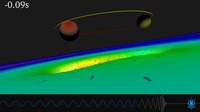
Photo from wikipedia
The properties of gravitational-wave (GW) propagation are modified in alternative theories of gravity and are crucial observables to test gravity at cosmological distance. The propagation speed has already been measured… Click to show full abstract
The properties of gravitational-wave (GW) propagation are modified in alternative theories of gravity and are crucial observables to test gravity at cosmological distance. The propagation speed has already been measured from GW170817 so precisely and pinned down to the speed of light, while other properties of GW propagation have not constrained tightly yet. In this paper, we investigate the measurement precisions of the amplitude damping rate (equivalently, the time variation of the gravitational coupling for GWs) and graviton mass in the generalized framework of GW propagation with the future detectors such as Voyager, Cosmic Explorer, and Einstein Telescope. As a result, we show that the future GW observation can reach 1% error for the amplitude damping. We also study the time variation of the gravitational couplings in Horndeski theory by performing Monte Carlo-based numerical simulations. From the simulation results, we find that the current accelerating Universe prefers the models with less damping of GWs and that the equivalence principle can be tested at the level of 1% by the future GW observation.
Journal Title: Physical Review D
Year Published: 2019
Link to full text (if available)
Share on Social Media: Sign Up to like & get
recommendations!